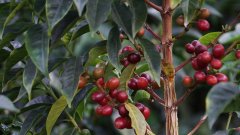Introduction to coffee bean blending knowledge and blending coffee need to know the flavor of coffee beans in all aspects
The blending of coffee beans is a subject of knowledge. It is necessary to be familiar with the flavor and taste of all kinds of coffee beans. After adding your own understanding, you can bake and prepare. If the landlord only tries it by himself, he can mix it at will without paying attention to it, just like painting. The individual paintings of cats and dogs are different, but if you want to make an in-depth study, it is recommended to taste more individual products first, and then try to mix them on your own after being familiar with the differences of all kinds of coffee beans. Where there is pay, there is gain! For some people who want coffee that tastes soft and not bitter, Arabica such as Columbia beans or Chagga in Tanzania can try, although Chagga has a slight acidity. For those coffee with strong flavor, it depends on how well it is roasted. Of course, for coffee, especially soft varieties like Brazil and Costa Rica, although you can roast them deep and taste strong, they can't be any more bitter. But if you add a little Robusta to it, you'll get a little astringent, a little bold. You can mix different flavors and characteristics in different combinations. Chagga-Java-Mocha is a good example, which includes the mellow taste of Java, the soft acidity of Chagga and the rich texture of Mocha.
The ideal way is to buy a small amount of raw beans, bake them yourself, and grind the beans directly before making coffee. However, most of us have to buy baked beans, and maybe this number will increase in the near future.
When storing beans, the biggest enemy is water. The volatile oils that give us aroma in the cup are soluble in water, and a humid environment can affect the oil. Do not store coffee in the refrigerator, because once the coffee is opened, the moisture will condense on the surface of the container.
If you want to store the coffee well at any time, the best way is to put it in the freezer and make sure it is encapsulated in a sealed bag. Baked beans can be stored in the freezer for more than a week. When you need them, don't try to thaw the beans, just put them in the grinder.
Another big enemy of coffee is oxygen, which breaks down volatile aromatic oils. This is the importance of grinding beans directly before making coffee. After the coffee is ground, its surface is exposed to the air, which means that the aromatic oil begins to volatilize and the flavor disappears in the air.
Don't store coffee next to products with strong flavors, such as tea. Coffee will quickly absorb the taste of other substances.
If you buy coffee by mail, it is best to buy only a small amount at a time. Although the quantity is good, you will lose the value of these coffees, just as you will lose their aroma.
Today, American consumers have more than 100 flavors of coffee to choose from, many of which are sold abroad. The production process of flavored coffee is to spread the roasted beans with medium oil and let them spray quickly in the fragrance to achieve. This practice began in the United States in the 1970s.
The most popular flavors are cocoa, mocha, bitter almonds and double cocoa. Orange wine and nutty flavors are also available, although strict coffee drinkers draw lines between raspberries, bananas and creamy beans to make a clear distinction. The newly introduced coffee flavor in the West is cardamom, which has long been added to coffee in the Middle East, while in Mexico, it is also a popular and traditional additive.

Important Notice :
前街咖啡 FrontStreet Coffee has moved to new addredd:
FrontStreet Coffee Address: 315,Donghua East Road,GuangZhou
Tel:020 38364473
- Prev

Plan of Origin strong Flower aroma of BlackBerry Fruit in Mirado Manor, Colombia
Boutique coffee (specialty coffee) is also called specialty coffee selection coffee. It refers to coffee made from a small number of raw beans with excellent taste grown in an ideal geographical environment. Depending on the special soil and climatic conditions in which they grow, they have outstanding flavor. After strict selection and classification, this kind of coffee is hard in texture, rich in taste and stylish.
- Next

What kind of weather conditions do you need to grow coffee beans? which countries have natural bars for growing coffee trees?
At present, coffee has been grown in more than 50 countries in the world, but most of the good coffee beans are concentrated in the equatorial zone between 25 degrees north latitude and 30 degrees south latitude, high altitude, tropical climate and fertile soil. in order to grow full-grained, coffee-rich high-quality coffee beans. Coffee beans are grown all over the world, mainly in Brazil, Colombia, Indonesia and Vietnam.
Related
- Does Rose Summer choose Blue, Green or Red? Detailed explanation of Rose Summer Coffee plots and Classification in Panamanian Jade Manor
- What is the difference between the origin, producing area, processing plant, cooperative and manor of coffee beans?
- How fine does the espresso powder fit? how to grind the espresso?
- Sca coffee roasting degree color card coffee roasting degree 8 roasting color values what do you mean?
- The practice of lattes: how to make lattes at home
- Introduction to Indonesian Fine Coffee beans-- Java Coffee producing area of Indonesian Arabica Coffee
- How much will the flavor of light and medium roasted rose summer be expressed? What baking level is rose summer suitable for?
- Introduction to the characteristics of washing, sun-drying or wet-planing coffee commonly used in Mantenin, Indonesia
- Price characteristics of Arabica Coffee Bean Starbucks introduction to Manning Coffee Bean Taste producing area Variety Manor
- What is the authentic Yega flavor? What are the flavor characteristics of the really excellent Yejasuffi coffee beans?

